Introduction
To coincide with the Fourth International Conference on Small Island Developing States (SIDS4) and to follow on from our article on developing subsea mineral licence regimes we have put together an overview of subsea minerals in various Pacific Island nations' Exclusive Economic Zones (EEZs).
We are fortunate to have collated a large amount of subsea information and scientific surveys, and are thankful to a range of entities (including the ISA, SBMA and others) for helping us with data transparency. Below is a simplistic overview of where subsea surveys indicate the potential presence of subsea minerals (predominately polymetallic nodules) and therefore which nations may be able to develop subsea mineral industries.
We do not wish to speculate, and the following information should be taken as a guide only. The presence of subsea minerals in a few survey locations alone is clearly insufficient to warrant investment or the creation of a full licence regime, but it nonethless indicates where governments or investors may wish to pay more attention or to commission further research.
Initial Observations
Polymetallic nodules typically occur on the deep abyssal plains of the world's oceans, and have been positively sampled from a wide range of locations across various EEZs in the South Pacific:
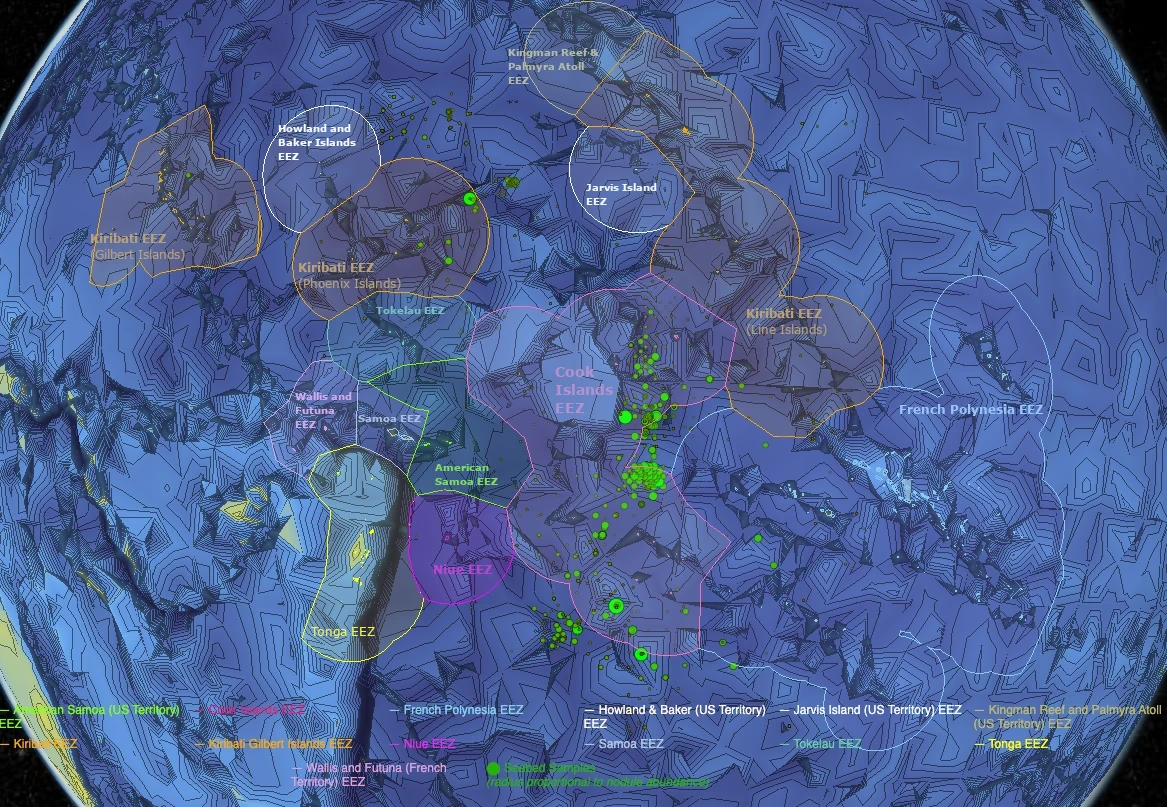 Bathymetric map of the South Pacific, showing various EEZs, with polymetallic metal abundances shown in green
Bathymetric map of the South Pacific, showing various EEZs, with polymetallic metal abundances shown in green
The image above shows:
- A bathymetric map of the South Pacific
- Ocean depth is indicated by increasingly dark shades of blue
- Land is indicated by brown
- Overlaid on this map are the EEZs of various island nations (jurisdiction is indicated by various colours)
- Also shown are green sample dots that indicate where scientific exploration cruises have reported sampling polymetallic nodules
- The diameter and intensity of each green dot is correlated with the nodule abundance reported, so that high densities of polymetallic nodules show as large, bright dots
It is clear from this map that the majority of polymetallic nodule samples have been taken in the Cook Islands EEZ, where there is an exciting and booming deep-sea mining industry developing. However, a large amount of samples have also been taken in other EEZs and in the surrounding International Waters.
This suggests that many other island nations possess subsea minerals in their EEZs and may be able to develop their own deep-sea mining industries. We'll outline these below.
Areas of Interest
The following areas are of particular interest, given their subsea geology and the presence of positive samples of polymetallic nodules:
- Cook Islands
- Kiribati
- French Polynesia
- "Donut hole" in International Waters between Cook Islands and French Polynesia EEZs
- American Samoa
- International Waters between the Phoenix Island and Line Islands EEZs of Kiribati
- Niue
- Tokelau
How Polymetallic Nodules Form
Before diving into the individual EEZs, it is important to summarise the conditions in which polymetallic nodules form:
- Moderate-to-low primary productivity
- Low sedimentation rate
- Below the Calcite Compensation Depth (CCD) - typically 5000-6000m
- Presence of source nucleus material
- Subdued small-scale seafloor topography
These factors are present across a wide range of areas across the South Pacific, resulting in polymetallic nodule formation.
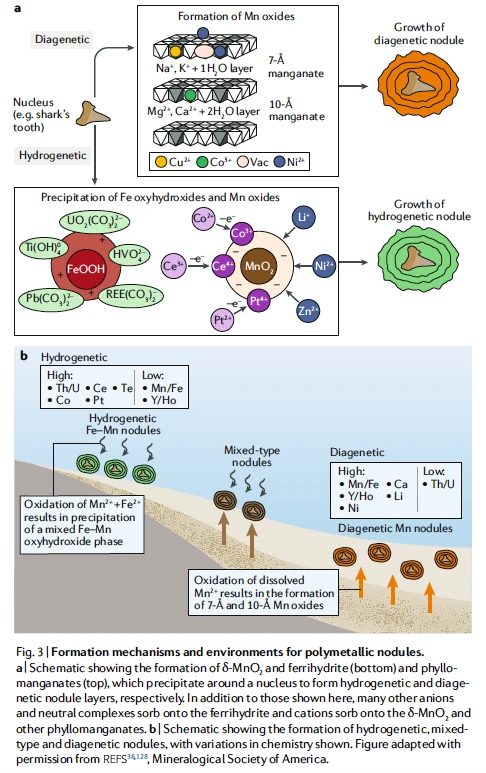 Formation mechanisms for polymetallic nodules, taken from Nature Reviews, "Deep-ocean polymetallic nodules as a resource for critical materials" by James Hein, Andrea Koschinksy and Thomas Kuhn
Formation mechanisms for polymetallic nodules, taken from Nature Reviews, "Deep-ocean polymetallic nodules as a resource for critical materials" by James Hein, Andrea Koschinksy and Thomas Kuhn
Cook Islands
Any description of polymetallic nodules in Pacific Island nation EEZs must start with the Cook Islands, where there has been significant and active exploration.
Subsea survey cruises in the Cook Islands began in the 1970s under CCOP/SOPAC. SOPAC cruises in the late 1980s provided ample data for an influential 1995 paper by Dr. Allen Clark that estimated 7bln tons of nodules in the EEZ, containing 32mln tons of Cobalt. This data, along with government policies and societal support, resulted in the formation of the Cook Islands Seabed Minerals Authority in 2012. A competitive tender for exploration in 2020, followed by the issuing of exploration licences in 2022, all spurred on exploration. The result is a very well surveyed and sampled EEZ:
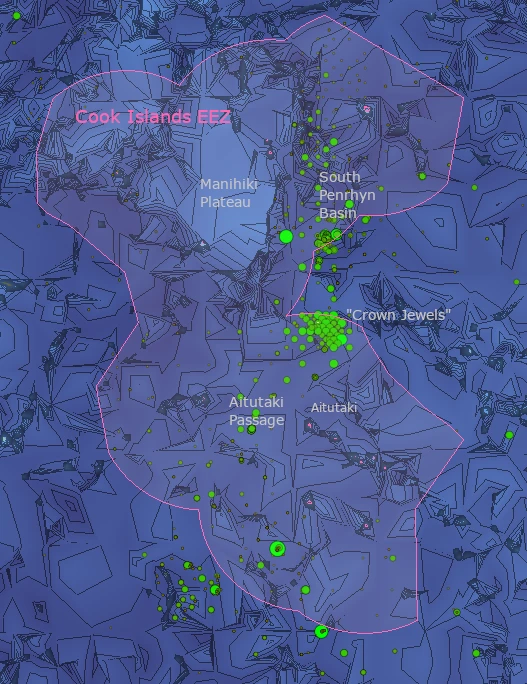 Bathymetric map of the Cook Islands EEZ with subsea samples shown in green
Bathymetric map of the Cook Islands EEZ with subsea samples shown in green
Whilst high densities of polymetallic nodules have been sampled in various locations across the Cook Islands EEZ, the main focus of current exploration is in the "Crown Jewels" cluster approximately 150nm North of Aitutaki. Nodule abundances upwards of 30kg/m² are found in this area, which are very dense and profitable. CSR and Moana Minerals both hold exploration licences in this area.
High densities of nodules can also be found South of the Aitutaki Passage, and further North in the South Penrhyn Basin alongside the Manihiki Plateau. CIIC holds exploration licences across a number of these areas.
Further information, along with an interactive bathymetric map and finite-element block model, can be found on the Cook Islands EEZ Data page.
French Polynesia
French Polynesia lies directly to the East of the Cook Islands. Whilst their EEZ is relatively poorly sampled, it nonetheless shares many of the subsea geological features of the Cook Islands EEZ, whilst surveys indicate good densities of polymetallic nodules:
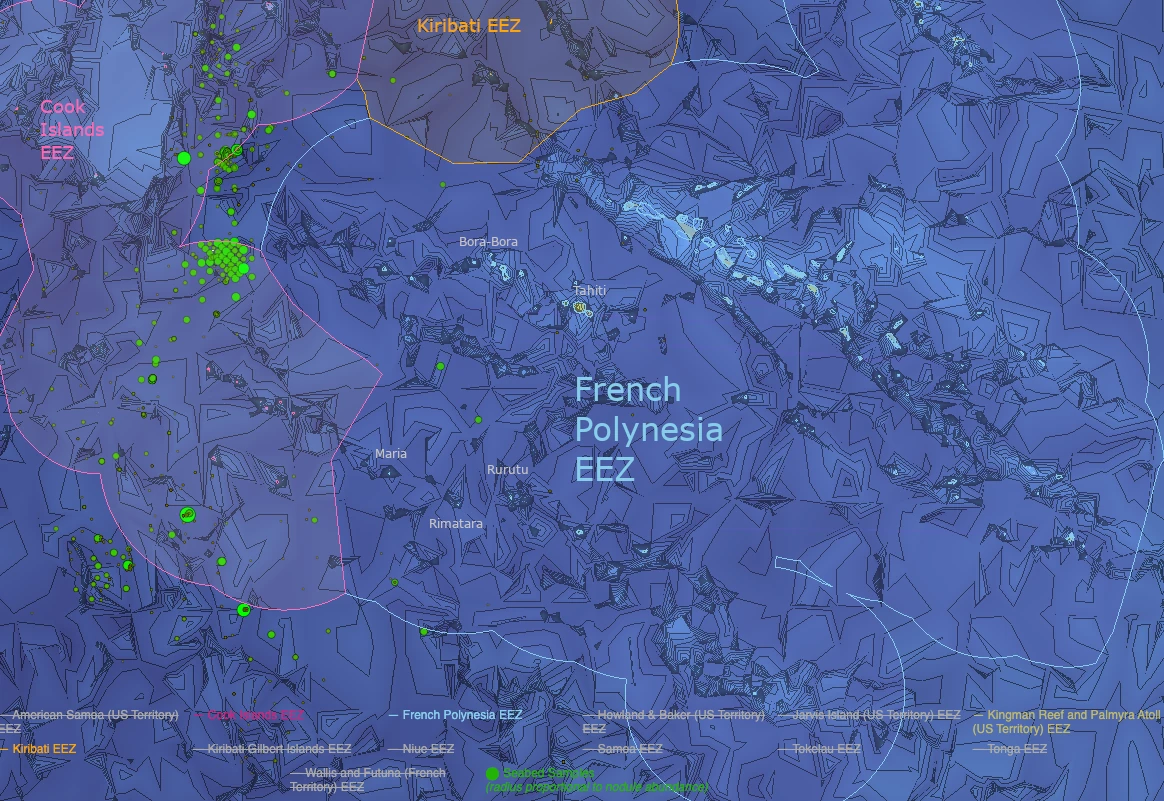 Bathymetric map of French Polynesia EEZ with subsea samples shown in green
Bathymetric map of French Polynesia EEZ with subsea samples shown in green
Seabed samples of nodules in the West of the EEZ (between the islands of Bora-Bora to the North, and Maria / Rimatara to the South) indicate excellent abundances of 28 and 32kg/m², with around 0.3% Cobalt and 1.2% Titanium by dry weight. (see Sbornak cruise of 1976, as reported in Murdmaa I.O., Skornjakova H.S., Bezrukov P.L. ZHelezomargan-cevye konkrecii Tihogo okeana.//Trudy IO AH SSSR, t.109, otv.red.Bez)
The North-West of the EEZ has 2 seabed samples indicating nodule abundances of 7.6 and 22.8kg/m². Otherwise the EEZ is very poorly explored, and there is the potential for subsea mineral resources across the area.
Samples take in International Waters South of both the Cook Islands EEZ and French Polynesia EEZ indicate abundances of up to 30-60kg/m². Similarly, the "donut hole" between both EEZs may hold signficant reserves, with a large amount of samples showing abundances in the range of 10-30kg/m².
In summary, French Polynesia's EEZ has many subsea geological similarities to that of the Cook Islands, and so holds great promise. It has been relatively poorly sampled, but where samples exist they indicate good abundances of Cobalt-rich polymetallic nodules.
Kiribati
Kiribati lies directly to the North-East of French Polynesia and the Cook Islands. The nation is comprised of 3 major island chains with 3 separate EEZs. These cover a large area of ocean and share many of the necessary characteristics for polymetallic nodule formation and/or similar circumstances to those found in the Cook Islands EEZ:
 Bathymetric map of the Kiribati EEZ around the Phoenix and Line Islands, with subsea samples shown in green
Bathymetric map of the Kiribati EEZ around the Phoenix and Line Islands, with subsea samples shown in green
The Eastern-most EEZ around the Line Islands has seen relatively little subsea sampling, with a sample point of 23kg/m² in the far South of the EEZ near the intersection of the Cook Islands and French Polynesian EEZs. Two other samples taken in the Southern part of this EEZ have shown low-to-negligible abundances.
Conversely, the Eastern part of the central Phoenix Islands EEZ has been significantly better sampled, with abundances here reaching 32 and 57kg/m² and 0.2 to 0.35% Cobalt: (see R/V "Hakurei-Maru" cruise of 1980, as reported in Mizuno,A., Nakao,S. (ed). "Regional data of marine geology, geophysics and manganese nodules" in 1982)
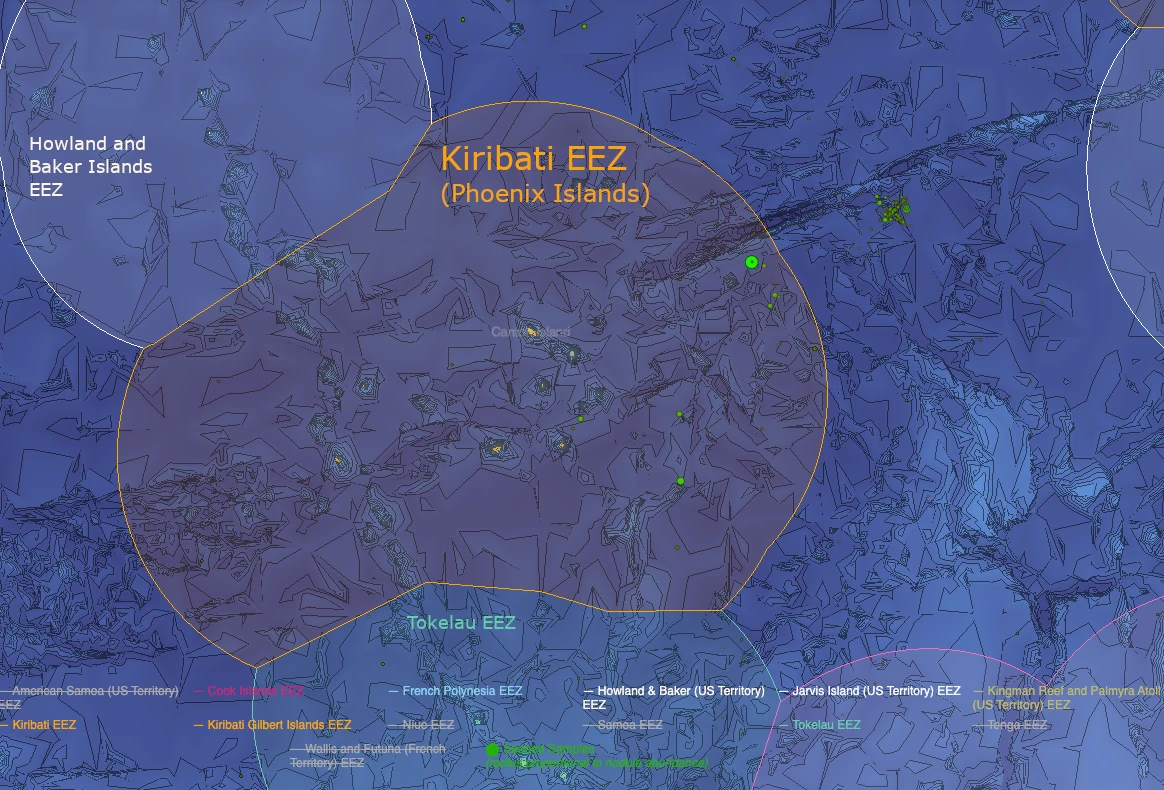 Bathymetric map of the Kiribati EEZ around the Phoenix Islands, with subsea samples shown in green
Bathymetric map of the Kiribati EEZ around the Phoenix Islands, with subsea samples shown in green
The Western-most EEZ around the Gilbert Islands is poorly sampled, with a single survey point indicating a low abundance of polymetallic nodules.
In summary, Kiribati EEZs cover large areas of ocean, and whilst they are relatively sparsely sampled, they nonetheless reveal areas of high densities of polymetallic nodule that may be very profitable for harvesting. Of particular interest are the areas to the far East of the Phoenix Islands EEZ, along with the Southern part of the Line Islands EEZ that likely has similar geological characteristics to the nearby Penrhyn Basin deposits in the Cook Islands EEZ. Further information can be found in our interactive model of the Kiribati EEZ.
American Samoa
American Samoa lies directly to the West of the Cook Islands, and whilst there are relatively few sample points, we believe that this EEZ may be very viable for subsea mineral development:
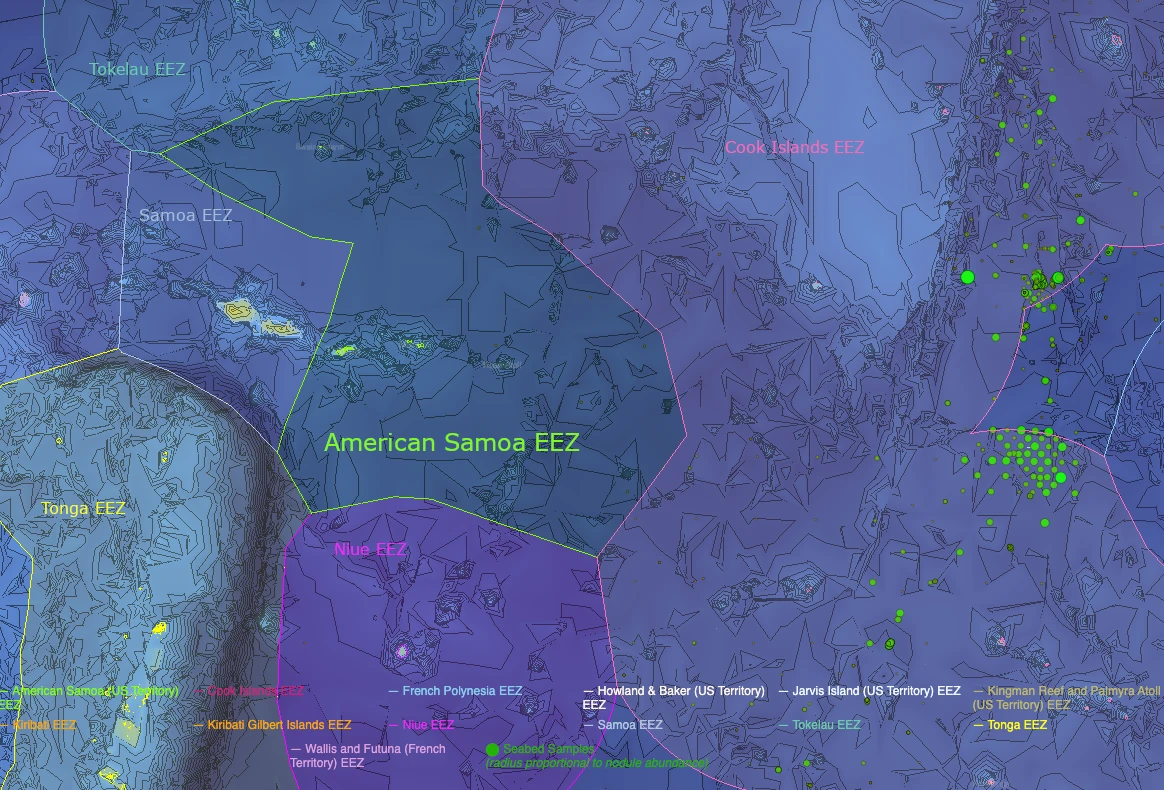 Bathymetric map of the American Samoa EEZ with subsea samples shown in green
Bathymetric map of the American Samoa EEZ with subsea samples shown in green
American Samoa's Exclusive Economic Zone (EEZ) lies alongside the Cook Island's EEZ. Bathymetry indicates many similarities between America Samoa's EEZ and the Cook Island's EEZ, suggesting that similar geological conditions may be present for the formation of polymetallic nodule resources. Further, samples taken on the abyssal plains in the American Samoan EEZ indicate moderate abundances of nodules.
"American Samoa EEZ is essentially unexplored for cobalt-rich crusts, (and) nodules...environments are present that offer targets for likely mineral occurrences." - James Hein, USGS
USGS reports indicate that polymetallic nodules and cobalt-rich crusts have been sampled in the East of the American Samoa EEZ, per the map below. The Samoan Basin is relatively uniform and between 5000-6000m deep, suggesting good conditions for the formation of polymetallic nodules.
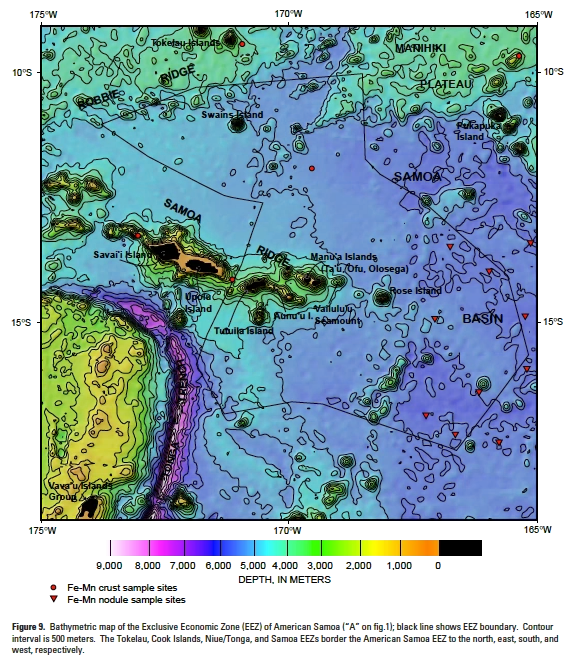 American Samoa bathymetry map and seabed samples, taken from "Marine Mineral Resources of Pacific Islands - A Review of the Exclusive Economic Zones of Islands of U.S. Affiliation, Excluding the State of Hawaii" by the USGS
American Samoa bathymetry map and seabed samples, taken from "Marine Mineral Resources of Pacific Islands - A Review of the Exclusive Economic Zones of Islands of U.S. Affiliation, Excluding the State of Hawaii" by the USGS
Further information can be found in our interactive model of the American Samoa EEZ.
Summary
The Cook Islands is in the process of developing a vibrant and valuable deep-sea mining industry, mainly focused on polymetallic nodules. This is the result of decades of subsea surveys and samples, along with directed government initiatives and strong societal support.
Beyond this area, the geological conditions in the Cook Islands that support polymetallic nodule formation are replicated across the South Pacific. Surveys and samples across this area indicate high densities of polymetallic nodules in other areas, albeit with less data and conviction than in the Cook Islands.
Based upon these samples and seafloor bathymetry, we believe that there is the potential to develop deep-sea mining industries in many other island nations. Of particular interest are the EEZs of French Polynesia, Kiribati, American Samoa and Niue, along with various areas in International Waters.
Clearly this development does not happen overnight, and we recommend that leaders reference our article on developing subsea mineral licence regimes.